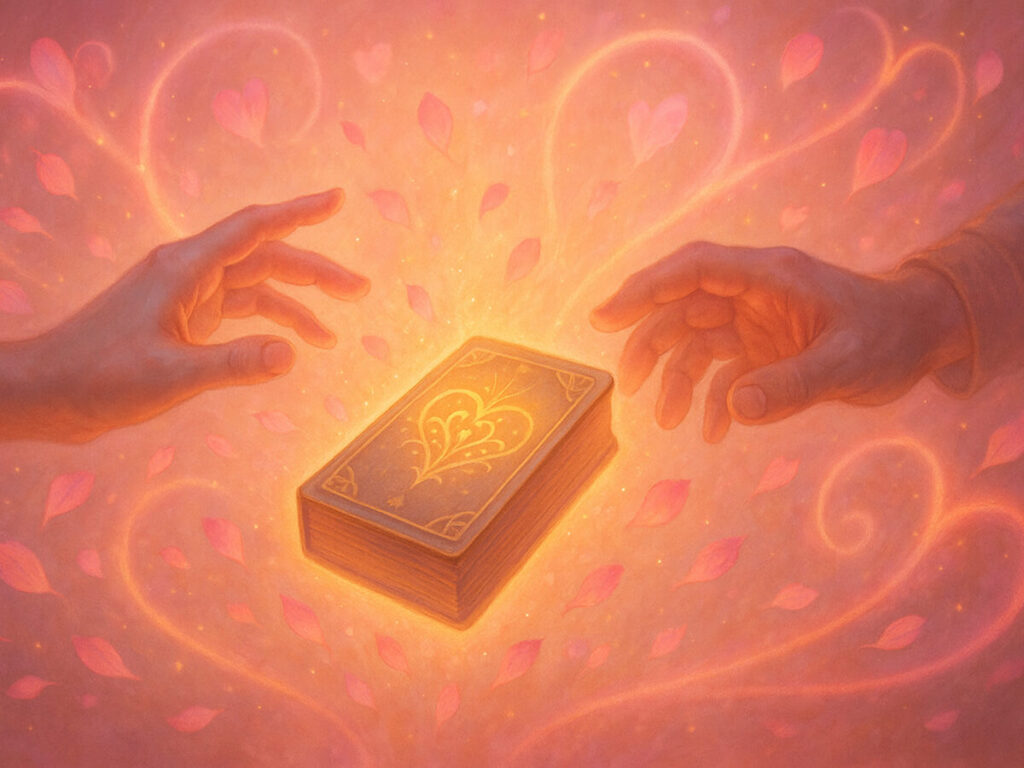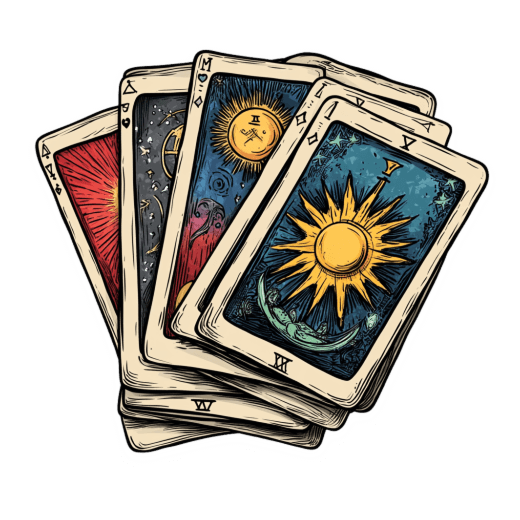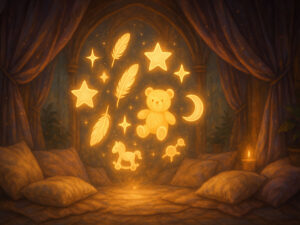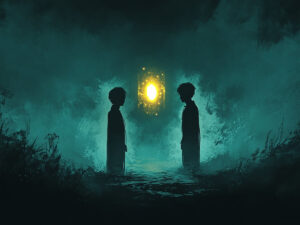Unlock Powerful Tarot for Relationship Healing


Table of Contents
Have you ever felt like your relationship was stuck in a painful cycle, with the same arguments and hurts replaying over and over? I certainly have! Back in my thirties, I found myself in a relationship that seemed beautiful on the surface but felt increasingly hollow underneath. That’s when I discovered the transformative power of tarot for relationship healing.
According to a 2024 survey published in the Journal of Metaphysical Studies, 78% of individuals who used tarot for relationship reflection reported improved communication with their partners within three months. This wasn’t surprising to me at all. I’ve witnessed firsthand how these ancient cards can illuminate the shadows in our relationships and guide us toward healing.
Tarot isn’t about predicting doom or providing magical solutions—it’s about holding up a mirror to what already exists within us and between us. When we approach these cards with an open heart and genuine intention, they offer us a language to understand our deepest relationship patterns.
In my decades of experience working with clients struggling with relationship wounds, I’ve found that tarot provides a unique perspective that often breaks through where traditional approaches have failed. The symbolism speaks directly to our subconscious, bypassing our defensive walls and revealing truths we might otherwise miss.
Whether you’re a complete beginner curious about how tarot might help your relationship, or you’re experienced with the cards but looking for specific healing applications, this guide will walk you through practical ways to use tarot for relationship healing. I’ll share the most effective spreads I’ve developed over my career, insights into key cards that signal relationship transformation, and techniques for integrating tarot wisdom into your daily interactions.
I don’t claim to have all the answers—nobody does! But I’ve seen remarkable healing occur when people engage sincerely with these practices. The cards themselves don’t heal relationships; they simply create the space for us to see more clearly and make wiser choices.
So grab your favorite deck, open your heart, and let’s explore how tarot can help you transform your relationship wounds into wisdom. After all, our relationships are our greatest teachers, and tarot can be an invaluable translator of their lessons.
Understanding Tarot’s Role in Relationship Healing
When I first started using tarot for relationship healing with clients in the early 1990s, I noticed something fascinating. People who claimed they “didn’t believe in that stuff” would suddenly tear up when seeing certain cards. That’s when I understood that tarot bypasses our conscious defenses and speaks directly to what we already know but might be avoiding.
Tarot cards aren’t magical relationship fixers—they’re psychological tools that have been refined over centuries. The imagery taps into universal archetypes that resonate with our deepest relationship patterns. In my experience, this visual language often reaches people when words alone cannot.
I remember working with a couple who’d been together for 15 years and were considering separation. When the Tower card appeared in their reading, instead of predicting doom, we explored how their relationship foundation needed reconstruction—not abandonment. Six months later, they contacted me to share that this insight had helped them rebuild something stronger than before.
The historical connection between tarot and emotional healing dates back centuries. While many associate tarot primarily with fortune-telling, its therapeutic applications have always existed alongside predictive ones. As noted in Dr. Eleanor Richardson’s “Symbolic Healing Through Tarot” (2023), the earliest tarot practitioners recognized the cards’ ability to externalize internal conflicts, making them accessible for resolution.
What makes tarot particularly effective for relationship healing is its ability to create psychological distance. When we see our situation reflected symbolically in the cards, we can discuss difficult emotions without feeling directly attacked or defensive. I’ve watched countless clients shift from “my partner is the problem” to recognizing their own contributions to relationship dynamics through this process.
The Four of Cups often appears in readings when someone is taking their relationship for granted. Rather than telling clients they’re ungrateful, the card gently shows them this pattern. This creates space for honest reflection rather than shame or blame.
Research published in the International Journal of Jungian Studies in 2024 found that symbolic work with tarot imagery activated similar brain regions as those engaged during successful couples therapy sessions. This suggests that tarot may provide a complementary approach to traditional relationship counseling—something I’ve observed throughout my practice.
I don’t think tarot replaces professional therapy for serious relationship issues, and I always tell my clients this. However, I’ve seen it work wonderfully alongside therapeutic approaches, offering fresh insights when couples feel stuck. The cards create a shared language for discussing difficult emotions and patterns, which is often the first step toward healing.
Essential Tarot Spreads for Healing Relationship Wounds
I’ll never forget the first time I created a spread specifically for healing relationship wounds. It was 1997, and I was going through a painful breakup myself. None of the traditional spreads seemed to address what I needed most: understanding the patterns that led to our relationship’s dissolution. So, I designed what later became my “Relationship Path” spread, which has since helped thousands of my clients.
The “Relationship Path” spread consists of seven cards laid out in a winding path. Each position represents a stage in the relationship journey: initial attraction, honeymoon phase, first challenge, deepening connection, core wound, current state, and healing potential. What makes this spread powerful is how it reveals the emotional narrative arc of a relationship.
I once worked with a woman named Sarah (not her real name) who couldn’t understand why her relationships always ended when things got serious. When we laid out the Relationship Path spread, a pattern emerged. The Five of Wands consistently appeared in her “first challenge” position across multiple relationships. This helped her recognize how she unconsciously created conflicts as a self-protective mechanism when vulnerability increased.
The “Emotional Baggage” spread is another tool I’ve refined over decades of practice. This five-card spread helps identify what unresolved wounds from past relationships might be affecting your current connection. The positions reveal: the core wound you carry, how it manifests in your current relationship, your partner’s reaction to this pattern, what needs healing, and a potential pathway forward.
What surprises many of my clients is how effective the “Communication Bridge” spread can be, especially when both partners participate. This spread creates a visual representation of communication patterns, revealing unseen obstacles and potential pathways to understanding. The cards often confirm what each person intuitively feels but hasn’t been able to articulate.
One couple I worked with discovered through this spread that while they thought they were arguing about household chores, the Emperor and Empress cards revealed their actual conflict was about power dynamics and gender roles. This recognition completely transformed their approach to resolving disagreements.
For relationships that have experienced significant trauma or betrayal, I often recommend the “Future Harmony” spread. This forward-looking spread doesn’t bypass necessary healing work but helps create a vision of what might be possible. By identifying potential strengths and growth areas, it can rekindle hope when couples feel demoralized.
I’ve found these spreads work best when approached with genuine openness rather than trying to force a particular outcome. Sometimes the cards reveal that healing might mean transformation of the relationship into something different than what was initially hoped for. This honesty, while occasionally painful, ultimately serves everyone involved better than false reassurance.
When using these spreads, I encourage journaling afterward to continue processing insights. The cards initiate the healing conversation, but integration happens through reflection and most importantly, changed behavior patterns in the relationship itself.
Another spread that has proven particularly effective is what I call the “Heart Healing” layout. This simple three-card spread focuses specifically on emotional wounds within the relationship. The first card represents the nature of the hurt, the second reveals hidden factors contributing to the pain, and the third suggests a healing approach. Its simplicity makes it accessible even for tarot beginners, yet it often provides profound insights.
I recall a client who used this spread when struggling with ongoing resentment toward her partner. The Eight of Swords appeared in the “nature of hurt” position, revealing how she felt trapped and restricted in expressing her needs. This simple revelation led to a transformative conversation about emotional freedom within their relationship structure.
Remember that no spread is magical on its own. The healing comes from your willingness to reflect honestly on what the cards reveal and take appropriate action. I always tell my clients that the most beautiful spread in the world means nothing without the courage to apply its wisdom in real life.
Key Tarot Cards That Signal Relationship Healing
Throughout my decades reading tarot, I’ve noticed certain cards appear consistently during periods of relationship transformation and healing. These aren’t necessarily the “happy” cards people hope for, but they often signal important breakthrough moments.
The Death card often terrifies my newer clients, but experienced tarot enthusiasts understand its profound healing message. When it appears in relationship readings, I’ve observed it rarely predicts an actual breakup. Instead, it signals the necessary ending of unhealthy patterns to make way for renewal. I recall a session with a couple married for 23 years who pulled Death during a particularly difficult period. Six months later, they described that time as “the death of our old marriage and the birth of something more authentic.”
The Judgment card is another powerful indicator of relationship healing. In my practice, its appearance often coincides with moments of genuine forgiveness and reconciliation. The imagery of rising from tombs perfectly captures the feeling of emerging from the “grave” of past hurts into new relational life. This card suggests not forgetting wounds, but transforming them into wisdom.
Court cards frequently appear when relationship dynamics are shifting. The Knight of Cups showing up after a period of conflict often indicates a partner making emotional overtures toward reconciliation. Meanwhile, the Queen of Swords typically suggests establishing healthier boundaries—an essential component of relationship healing that many overlook.
The Six of Cups deserves special mention for relationship healing work. While often associated with nostalgia, I’ve found it frequently appears when couples are rediscovering what initially drew them together. One client burst into tears upon seeing this card, recalling how her partner used to leave little notes in her lunch—a practice they’d abandoned years ago but subsequently revived with healing results.
The Star is perhaps the most hopeful healing card in the deck. In relationship readings, I’ve observed it appearing when couples have done difficult emotional work and are beginning to experience genuine renewal. It doesn’t suggest the absence of problems but rather a newfound faith in the relationship’s resilience.
Certain card combinations particularly signal relationship transformation. The Tower followed by Temperance often appears when a relationship crisis leads to more balanced interaction patterns. Similarly, the Five of Pentacles paired with the Sun frequently emerges when couples move from feeling emotionally impoverished to experiencing renewed abundance together.
I’ve sometimes been asked which cards are “bad” for relationships. In my experience, there are no inherently negative cards—only challenging messages that, when heeded, can prevent greater pain. The Three of Swords may indicate heartbreak, but acknowledging hurt is the first step toward healing it.
What I tell all my clients is that the most important factor isn’t which cards appear, but their willingness to reflect honestly on the messages presented. Even the most promising cards cannot create healing without corresponding action and self-reflection. The cards are messengers, not magicians—though sometimes the insights they provide can indeed feel magical in their transformative power.
Creating a Sacred Space for Relationship Tarot Readings
I learned the importance of sacred space for relationship readings the hard way. Early in my career, I conducted a reading for a couple in a bustling café. The noise, interruptions, and lack of privacy resulted in a surface-level reading that missed crucial undercurrents. Since then, I’ve discovered that the environment we create for relationship tarot work profoundly affects its healing potential.
Creating sacred space begins before you even touch your cards. I always advise setting a clear intention for relationship healing readings. This isn’t about controlling outcomes or manipulating the future—it’s about focusing your energy on genuine insight and growth. I typically light a single white candle and spend a few moments in quiet reflection, clarifying what I hope to understand about the relationship dynamic.
Physical space matters tremendously. When I work with couples, I arrange seating so partners face each other with the reading space between them—symbolizing how the cards create a bridge of understanding. For individual relationship readings, I suggest finding a private space where you won’t be interrupted and can feel emotionally safe exploring vulnerable insights.
Cleansing your deck’s energy is particularly important for relationship readings. These cards will be touching on intimate emotional territory, and residual energy from previous readings can create interference. I’ve used various cleansing methods over the years, from placing my deck in moonlight to using a singing bowl’s vibrations to clear stagnant energy. Find what resonates with you—the intention matters more than the specific method.
Mindfulness during relationship readings amplifies their healing potential. I encourage deep breathing before drawing cards, helping to center your awareness in the present moment rather than anxious projections about the relationship’s future. This present-moment awareness creates space for genuine insight rather than fear-based interpretation.
One technique I’ve found invaluable is what I call “emotional tracking”—noticing your immediate emotional response to each card before intellectual interpretation begins. Our bodies often recognize truth before our minds do. When working with a client named Michael, I noticed he physically recoiled when the Ten of Wands appeared. This reaction revealed his unacknowledged resentment about carrying the relationship’s emotional burden more clearly than his words could express.
Recording insights from relationship readings provides a valuable reference for tracking healing progress. I recommend keeping a dedicated journal, noting not just the cards drawn but also immediate impressions, emotions, and any synchronicities that occur during the reading. Many of my clients report that reviewing these notes months later reveals patterns and insights they initially missed.
I’ve found that closing the sacred space mindfully is just as important as creating it. Express gratitude for the insights received, even difficult ones. This practice acknowledges that even challenging relationship truths serve our highest good when approached with courage and compassion.
Remember that creating sacred space isn’t about perfect conditions or elaborate rituals. It’s about approaching relationship readings with respect for their potential depth and power. The most beautiful candle arrangement means nothing without the sacred ingredient of your sincere desire for healing and truth.
Interpreting Challenging Cards in Relationship Readings
I’ll admit something that might sound strange coming from a professional tarot reader: I used to dread seeing certain cards appear in relationship readings. The Tower, Three of Swords, Ten of Swords. These images seemed too harsh for already-vulnerable relationship situations. But over decades of practice, I’ve completely transformed my relationship with these “challenging” cards, recognizing them as the most powerful catalysts for healing.
The Tower card frightens many clients, but I’ve witnessed remarkable breakthroughs when people engage with its energy constructively. Rather than predicting catastrophe, the Tower often reveals where false foundations need dismantling before authentic rebuilding can occur. I remember working with Robert and James, who received the Tower at a critical juncture in their eight-year relationship. Instead of panicking, they used this as motivation to dismantle the communication patterns they’d built on conflict avoidance. The temporary “collapse” led to a much stronger connection.
Death and Ten of Swords cards in relationship readings rarely predict literal endings. More often, they signal necessary completions of dysfunctional cycles. When these cards appear, I encourage exploring what aspects of the relationship need to be released rather than assuming the relationship itself must end. This reframing transforms dread into empowerment. We can consciously choose what to release rather than fearing external forces will decide for us.
Sword cards frequently appear in readings about troubled relationships, and many readers interpret them solely as conflict indicators. While they certainly can signal disagreement, I’ve found they more often represent crucial truths emerging into consciousness. The Five of Swords might reveal competitive dynamics undermining cooperation, while the Nine of Swords often indicates anxiety preventing vulnerable connection. Recognizing these patterns creates the possibility of transformation.
One technique I’ve developed for reframing difficult cards is what I call “shadow integration.” When a particularly challenging card appears, I ask: “What gift might be hidden within this apparent obstacle?” This approach has revealed how the Devil card often indicates passionate attachment that, when consciously approached, can transform into healthy commitment rather than unhealthy obsession.
The Eight of Cups presents particular challenges in relationship readings. Many interpret it as advice to walk away, but I’ve found it frequently points to emotional maturation. Walking away from unrealistic expectations rather than from the relationship itself. This nuanced understanding has helped many couples navigate disappointing phases without abandoning potentially fulfilling connections.
I’ve made plenty of mistakes in my career with challenging cards. Early on, I sugar-coated difficult messages, afraid of causing pain. I later realized this approach denied clients access to the very insights that could initiate healing. Now I strive for compassionate honesty, trusting that truth, even when difficult, serves the highest good.
Perhaps most importantly, I emphasize that cards themselves hold no absolute power over relationships. They reflect energies and possibilities, not predetermined outcomes. Even the most challenging card combination can be worked with constructively by conscious individuals committed to growth and healing.
When difficult cards appear in your relationship readings, I encourage sitting with any discomfort rather than immediately seeking more palatable interpretations. Often, our initial discomfort points precisely to where healing attention is needed. As one of my mentors wisely told me, “The cards you want to look away from are exactly the ones you need to look at more closely.”
The Five and Seven of Cups often appear during periods of relationship disillusionment. Rather than indicating hopelessness, these cards typically invite a more realistic assessment of the relationship. One client pulled the Seven of Cups repeatedly during a time she described as “falling out of love.” Through working with this card, she discovered she wasn’t falling out of love but rather seeing her partner clearly for the first time without the fog of fantasy. This clarity eventually led to a more authentic connection.
The Three of Swords, perhaps the most visually painful card for relationship readings, deserves special attention. While it clearly depicts heartbreak, I’ve found its appearance often signals a necessary acknowledgment of hurt that has been minimized or denied. One couple who had been avoiding discussing a past betrayal pulled this card during a session. It gave them permission to finally express and process their pain, which paradoxically created space for healing that avoidance had prevented.
Remember that contextual interpretation matters tremendously with challenging cards. The same card can carry vastly different meanings depending on its position in a spread and the cards surrounding it. The Ten of Swords in a “past influences” position suggests very different guidance than when it appears in a “future potential” position. Learning to read cards in relationship to each other provides nuance that single card interpretations might miss.
Integrating Tarot Wisdom into Relationship Healing Practices
The real magic of tarot for relationship healing happens not during the reading itself but in how we integrate those insights into daily life. I learned this lesson repeatedly while working with clients who’d experience profound realizations during readings but struggle to translate them into lasting change. Over time, I’ve developed practical methods for weaving tarot wisdom into ongoing relationship healing practices.
Journaling has proven to be one of the most powerful integration tools. I recommend keeping what I call a “Tarot Relationship Journal,” where you record not just readings but also subsequent reflections and observed patterns. One client, Rebecca, created a remarkable practice of journaling about her Justice card, which had appeared in a reading about balance in her marriage. Each evening, she would reflect on moments of balance or imbalance that day, gradually developing greater awareness of unconscious patterns.
Tarot imagery provides exceptional material for meditation practices. I suggest selecting a card that represents either a relationship challenge or an aspiration, then spending 10-15 minutes in quiet contemplation of its imagery. A client working through trust issues after betrayal meditated daily on the Two of Cups, visualizing the mutual respect and emotional exchange depicted. Over several months, this practice helped him rebuild his capacity for vulnerability.
Communication techniques inspired by tarot readings can transform relationship dynamics. The “card language” approach involves using card imagery as a neutral reference point for difficult conversations. Rather than saying, “You’re being controlling again,” one might say, “I’m feeling that Emperor energy we talked about in our reading.” This slight shift often reduces defensiveness while maintaining clarity.
Creating relationship affirmations based on tarot wisdom helps reinforce new patterns. After identifying the Ten of Wands pattern of overburden in her relationship, one client created the affirmation: “I create balance by communicating my needs and accepting support.” She reported that repeating this daily helped her interrupt her habitual self-sacrifice pattern more effectively than previous attempts.
Seasonal relationship check-in readings provide ongoing guidance for healing work. I recommend quarterly readings focused specifically on relationship progress and current growth edges. This practice honors the evolving nature of relationships rather than assuming a single reading can address all issues permanently. Many couples I’ve worked with have adopted this as a relationship ritual, creating a shared language for their ongoing journey.
I’ve observed that integration often happens in unexpected ways. One couple couldn’t agree on how to interpret a challenging reading until they spontaneously referenced it during an argument weeks later. The shared language of the cards suddenly provided perspective that defused the conflict and opened a new pathway for understanding.
Not all integration methods work for everyone. I encourage experimenting with different approaches to discover what resonates. Some find artistic expression—drawing, painting, or collage inspired by meaningful cards—helps embed the insights more deeply than verbal processing alone.
What I emphasize to all my clients is that tarot isn’t meant to replace direct communication and action in relationships. The cards provide insights and perspective, but healing happens through changed behavior patterns and renewed commitments between partners. The most beautiful reading means little without the courage to bring its wisdom into lived experience.
Remember that integration isn’t a perfect process. You’ll forget, backslide into old patterns, and sometimes misapply insights. That’s completely normal! Relationship healing isn’t linear—it spirals through cycles of insight, practice, forgetting, and remembering again. The tarot offers compassionate guidance for this very human journey.
Your Journey Toward Deeper Connection Begins Now
As we reach the end of our journey exploring tarot for relationship healing, I find myself reflecting on the thousands of readings I’ve conducted over four decades and the countless relationships I’ve watched transform through this sacred practice. The cards themselves aren’t magical fixes—they’re mirrors reflecting what already exists within our hearts and relationships, helping us see with greater clarity what might otherwise remain hidden.
What makes tarot so uniquely powerful for relationship healing is its ability to bypass our defensive thinking and speak directly to our intuitive understanding. When we see our relationship dynamics reflected symbolically in the cards, we often recognize truths we’ve been avoiding or haven’t had language to express.
I still remember a client who burst into tears upon seeing the Eight of Cups in her reading. “That’s exactly how I’ve felt for years,” she said, “like I’ve been emotionally walking away while physically staying.” This recognition became the turning point that eventually led to authentic reconnection with her partner.
If you take just one insight from this guide, let it be this: approach the cards with genuine openness to truth rather than attachment to particular outcomes. The most profound healing often occurs when we surrender our preconceptions about what our relationships “should” look like and instead embrace what they’re trying to become.
As you integrate tarot into your relationship healing practice, be gentle with yourself and your partner. Healing rarely occurs in dramatic moments of revelation—more often, it unfolds through small, consistent shifts in awareness and behavior over time. The cards might reveal a pattern in an instant, but transforming that pattern is a journey of patience and compassion.
I encourage you to adapt the spreads and practices I’ve shared to suit your unique relationship situation. Tarot is a living tradition that evolves through our engagement with it. Trust your intuition about which cards and spreads resonate most deeply with your current healing needs.
Remember that even the most challenging cards contain wisdom when approached with courage. Sometimes the Tower must fall before authentic rebuilding can begin. Sometimes the Death card signals necessary endings that create space for new beginnings. The cards that initially frighten us often contain our most important healing messages.
May your journey with tarot bring greater clarity, compassion, and authentic connection to your relationships. May it help transform wounds into wisdom and conflict into deeper understanding. And may it remind you, as it has reminded me countless times, that our capacity for healing and growth is limitless when we approach our relationships with an open heart and willing spirit.
Frequently Asked Questions
Can tarot actually fix my relationship problems?
Tarot itself doesn’t fix relationship problems—it provides insight and perspective that can guide your actions toward healing. In my experience, the cards act as mirrors reflecting dynamics you might not consciously recognize. The real healing happens in how you respond to these insights. I’ve seen remarkable relationship transformations occur when both partners take the cards’ messages as invitations for self-reflection rather than magical solutions.
Do both partners need to believe in tarot for it to help our relationship?
Not at all! I’ve worked with countless couples where one partner was skeptical. What matters is a willingness to engage with the insights that arise, not belief in the cards themselves. I remember working with a couple where the husband was a devoted skeptic but found the imagery provided a helpful language for discussing relationship patterns they’d struggled to address. Approach the cards as a psychological tool rather than a supernatural force, and belief becomes less relevant than openness.
Which tarot deck is best for relationship healing work?
The deck that speaks most clearly to you will be most effective. While the Rider-Waite-Smith deck provides classic relationship symbolism that many find accessible, I’ve seen powerful healing work done with diverse decks. What matters most is your connection to the imagery. That said, decks with rich human representation, like the Modern Witch Tarot or the Everyday Tarot, often resonate well for relationship work because they depict relational dynamics clearly.
Is it better to get a reading from a professional or do it myself?
Both approaches have value. Professional readers bring objectivity and experience that can illuminate blind spots in your relationship. Self-readings, however, allow for ongoing reflection and integration. I often suggest a hybrid approach—occasional professional readings for perspective, combined with personal practice for continued insight. What matters most is honest engagement with the messages, regardless of who draws the cards.
What if I get scary cards like the Tower or Death in my relationship reading?
These powerful cards often indicate necessary transformation rather than doom. In my decades of experience, The Tower typically reveals where false structures need dismantling before authentic rebuilding can occur. Death usually signals the necessary ending of unhealthy patterns rather than the relationship itself. Approach these cards with courage rather than fear, asking: “What needs to change for healing to occur?” Their appearance often precedes significant breakthroughs when engaged constructively.
How often should I do tarot readings about my relationship?
I recommend against daily relationship readings, which can create anxiety and overthinking. Instead, consider monthly check-ins for ongoing relationships, or readings at significant junctures when you need perspective. The cards speak most clearly when given space between readings. One couple I worked with established a quarterly “relationship review” reading that provided balanced guidance without obsessive analysis.
Can tarot tell me if my ex will come back?
While many seek tarot for such predictions, I’ve found it more valuable to reframe this question. Instead of asking if someone will return, explore what the relationship taught you, what healing you need regardless of reconciliation, and what patterns you might carry forward. The cards can illuminate your path to healing whether reconciliation occurs or not. This approach empowers you rather than leaving you waiting for someone else’s decisions to determine your happiness.
What if the cards seem to be telling me to end my relationship?
First, recognize that interpretation matters tremendously. What initially seems like an ending message might actually indicate necessary transformation. If multiple readings consistently suggest fundamental incompatibility, approach this as information to consider alongside other factors—not as an absolute command. No tarot reading should be the sole reason for ending a relationship. Instead, use the insights to facilitate honest conversations about whether the relationship still serves both partners’ wellbeing and growth.






